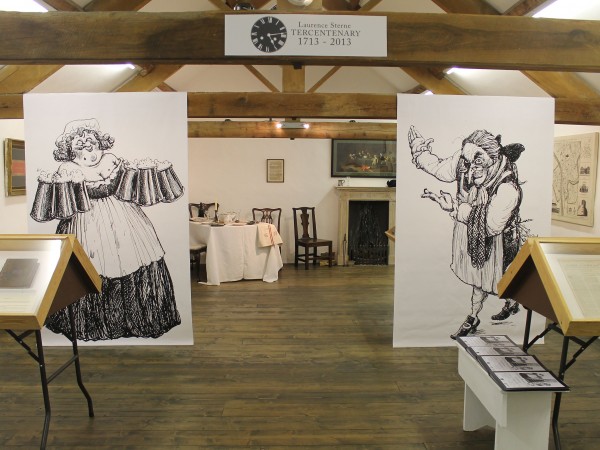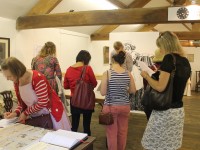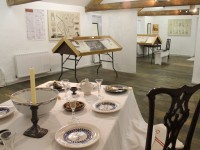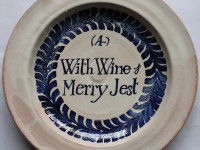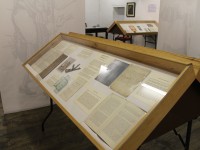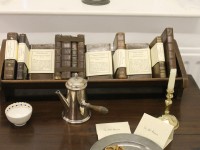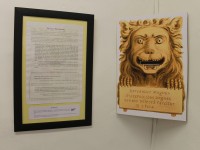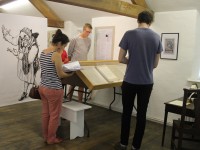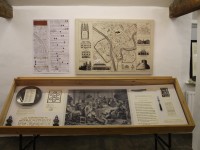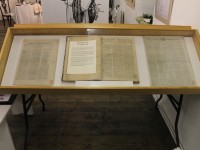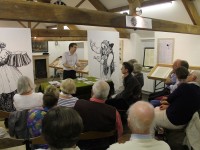Exhibition
Shandy Hall Gallery, 30 June – 30 September 2013
Overview
This exhibition project began with the discovery of a manuscript minute book in the collection at Shandy Hall. The leather-bound volume, stamped ‘GOOD HUMOUR’ on the front cover, recorded the workings of a gentleman’s club that met in 18th century York. Several of its members were closely associated with Laurence Sterne. The Good Humour Club met above Sunton’s Coffee house in Coney Street, which Sterne was known to frequent.
The ideal of ‘Good Humour’ chimes so strongly with Sterne’s central concept of Shandeism that it seemed an excellent exhibition to hold in this Tercentenary year. Sterne fought poor health with mirth and Tristram Shandy was written to defeat melancholy.
Martin Rowson’s cartoon versions of Mr and Mrs Sunton welcome you into this impressionistic reconstruction of a coffee house and gentleman’s club.
There are two ‘scenes’. On the right of the entrance, Sterne has just written to his friend John Hall Stevenson on struggles with flesh and the devil, and at the far end of the room the bust of Voltaire seems to look down on an imperfect world with an expression of mild geniality. The exhibition cases and remaining interpretation explore the themes of the health benefits of good humour and the results of research on the two minute books by students and community volunteers.
Background
Research on the first Good Humour Club minute book by Northumbria University led to the discovery of a second held in York Minster Library that had been previously examined and researched by J.W.Knowles. (The hunt is on for two further minute books which are known to have existed.) Together they provide a unique insight into 18th century York and some of Sterne’s close associates: Theophilus Garancieres was his apothecary, Revd. Bridges was a fellow clergyman who covered Sterne’s duties while he was writing, Caesar Ward’s wife Ann published Tristram Shandy and John Hinxman was the bookseller who sold it.
The Good Humour Club was also known as the ‘Doctors Club’ because its members, regardless of their various trades or professions, called each other ‘Doctor’.
Modern medicine also recognises that good humour can have a positive influence on health and wellbeing, so that doctors are now prescribing books in partnership with local libraries. The Moodboosting Books promotion by Reading Well is the most recent manifestation of a tradition that goes back at least as far as Thomas d’Urfey’s collection of songs and poems Wit and Mirth: Pills to Purge Melancholy of 1719.
Study of the contents of the Good Humour Club minute books reveals much about aspects of 18th century life, including food, medicine, money, the history of York and the individual members of the club.
18th century local newspapers have played a major role in the background research carried out by students and volunteers, some of which is displayed here, and which will continue throughout the exhibition period.
A major discovery made during the research – the exact publication date of the first volume of Tristram Shandy – has solved one of the most long-standing mysteries of Sternean research and has attracted national attention.
A play set in the Good Humour Club immediately after the first publication of Tristram Shandy will be broadcast as a podcast in December.
The information gathered so far is recorded on the Laurence Sterne Trust website and will continue to expand as fresh knowledge is discovered.
Thanks to: The Heritage Lottery Fund, York Minster Library, North Yorkshire Library and Community Services, York Explore Library, York Museums Trust, Nigel Hutchinson, Tom Wood, Nigel Wallace, Andrew Woods, Geoff Day, Northumbria University and Jane Wu
Researchers: Bill Cleghorn, Simon le Gassicke, Pamela Martin, Chris Pearson, Helen Williams, Ashleigh Blackwood, Danielle McDonnell, Alex Hardie-Forsyth, Richard Hinxman and Jill Murray – whose grandfather J.W.Knowles wrote about the Minster Library minute book. The transcription and research carried out by Jill and her husband Hugh on both this and the Shandy Hall volume laid the foundations for this exhibition.
The Good Humour Club exhibition owes a considerable debt to the outstanding research work of Hugh Murray (1933–2013). This project is dedicated to his memory with affection and thanks.
